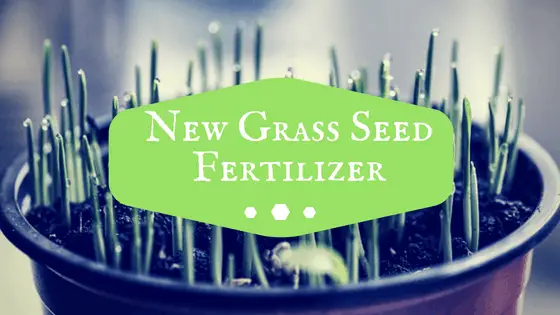
One of the keys to establishing a lush new lawn from grass seed is to use an appropriate fertilizer. You should avoid applying the majority of fertilizers found at your local hardware store.
Many of these fertilizers will kill or harm your new lawn. You should especially not purchase “weed and feed” or “crabgrass preventers” not designed for new grass. So, what fertilizer should you use on your new lawn?
Table of Contents
Fertilizer to use on New Grass
The recommend new grass fertilizer you should buy is starter fertilizer. This type of fertilizer is designed to improve your seeding results while also not doing harm to the seedlings.
The nutrients in starter fertilizers are nitrogen (N), phosphorus (P), and potassium (K). According to the University of California, the phosphorus component of starter fertilizer is the vital nutrient to promote root development, while nitrogen helps grow the sprouted grass once it develops.
The University of California recommends the following application rates for various types of fertilizers that may contain the following N-P-K ratios. Most fertilizers will have the N-P-K ratios clearly printed on the bag.
| Fertilizer (N-P-K) | Application Rate (lbs. per 1,000 sq. feet) |
|---|---|
| 5-10-5 | 20 |
| 5-20-10 | 20 |
| 10-20-10 | 10 |
| 16-20-0 | 6 |
The above table may be confusing to some readers and that is not problem. The starter fertilizer bag you purchase will commonly indicate the appropriate spreader setting to use on your seeds.
Organic Fertilizers
Instead of starter fertilizer, you can also use some organic fertilizers on your new seed. Products such as Ringer Lawn Restore (10-0-6) or Milorganite (6-4-0) may be used as a safe options to promote seed and lawn growth. I personally use Milorganite for general fertilizing purposes, and have had exceptional results.
Beyond Fertilizer
Starter fertilizer is not necessary to grow new grass. When I was a struggling new homeowner several years ago, I seeded many areas of my lawn with just Scott’s lawn seed and junky top soil.
The grass eventually grew with plenty of watering, although it was patchy in some areas. Having since used starter fertilizer on many occasions, I can tell you that it does indeed produce a thicker lawn with faster growth.
While starter fertilizer is an important component to growing an ideal lawn, you should not forget the fundamentals.
Be sure to do research to find a quality grass seed that can thrive in your climate zone. Grass seed does go bad . Once you decide on your seed, make sure it is fresh seed that has not expired. The grass seed bag often reflects the expiration date for your reference.
You should water at least twice a day to keep the seeds moist. When seeds dry out, they die. You should monitor the seeded area to make sure the soil is damp at all times. However, the seed bed also should not be flooded.
Seed only when conditions are ideal for growing. For many people this means spring or better fall. These seasons produce ideal soil temperatures to give your seeds the best opportunity to grow.
Additionally, do not be tempted to cut your newly established lawn until the time is right. Wait until it grows to approximately 4 inches before doing your first mow.
Michigan State University recommends mowing your lawn at 3.5 to 4 inches. To cut your lawn at this height, often means raising the mowing deck to its highest point. Mowing high will help shade out weeds, deter grubs, promote a healthy root system, and lower the chances of scalping your lawn.
You should be patient with your newly seeded lawn. Depending on the seed, it can take up to 30 days to just begin to germinate. Kentucky Bluegrass is an example of a seed that typically takes longer to germinate.
After germination, the lawn will take a couple of months to thicken up and look presentable. You should expect at least a few weeds to pop up in your new grass. Do not use weed killers until it is recommended by the seed manufacturer. I personally wait until the following season to deal with any weed problems.
Good luck with your new lawn! I hope you will have the greenest yard on the block.

